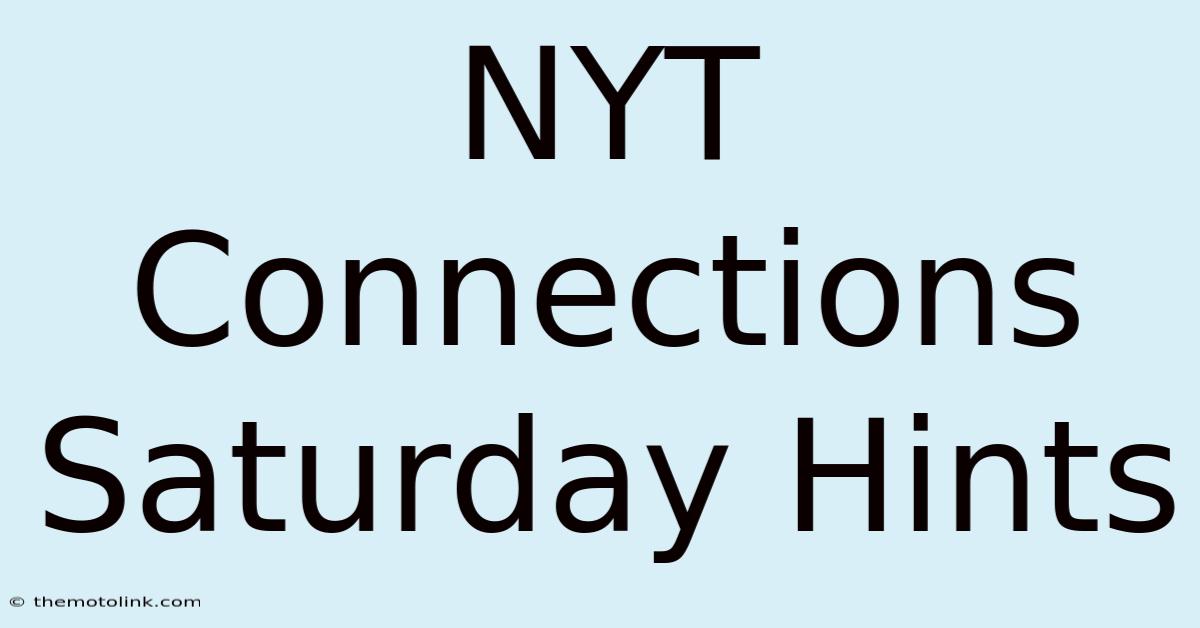NYT Connections Saturday Hints

Discover more detailed and exciting information on our website. Click the link below to start your adventure: Visit Best Website nimila.me. Don't miss out!
Table of Contents
NYT Connections Saturday Hints: Mastering the Art of the Puzzle
The New York Times Connections puzzle, a Saturday staple for many word game enthusiasts, presents a unique challenge: finding the single word that connects three seemingly disparate terms. This week’s puzzle, and indeed every week's, requires keen observation, lateral thinking, and a healthy dose of wordplay. Let's delve into strategies and hints to help you master the art of cracking the NYT Connections Saturday puzzle.
Understanding the NYT Connections Puzzle Mechanics
The core premise of the NYT Connections puzzle is simple yet deceptively complex. You're given three words, often unrelated at first glance. Your task is to identify a single word that creates a meaningful connection between all three. This connection might be based on synonyms, antonyms, shared characteristics, wordplay (like anagrams or hidden words), or even more abstract relationships. There’s usually only one correct answer, demanding precision and thorough consideration.
Strategies for Solving NYT Connections Saturday Hints
1. Brainstorming and Word Association: Start by individually examining each of the three words. What immediately comes to mind? List synonyms, antonyms, and related concepts. Think outside the box – don't limit yourself to the most obvious associations. Freewriting or mind-mapping can be incredibly helpful here.
2. Considering Different Word Relationships: The connection isn't always straightforward. It might involve:
- Synonyms/Antonyms: One word might be a synonym or antonym of another, and the connecting word reflects this relationship. For example, if you have "large," "small," and "immense," the connecting word could be "size."
- Shared Characteristics: The three words might share a common characteristic or category. For instance, "apple," "banana," and "orange" are all "fruits."
- Wordplay: The puzzle might involve anagrams, hidden words, or phonetic similarities. Keep an eye out for these subtle connections.
- Conceptual Links: The connection could be based on a more abstract concept or shared association, requiring deeper thought and creative problem-solving.
3. Using External Resources Sparingly: While it's tempting to reach for a thesaurus or dictionary immediately, try to solve the puzzle using your own knowledge first. This strengthens your vocabulary and problem-solving skills. However, if you're truly stuck, consulting a thesaurus or online dictionary can provide helpful clues, focusing on synonyms and related words.
4. Reviewing Past Puzzles: Familiarize yourself with previous NYT Connections puzzles. By analyzing past puzzles and their solutions, you can identify common patterns and strategies that might help you in the future. This builds your intuition and recognition of various connection types. The NYT website itself archives past puzzles.
5. Utilizing Online Resources and Communities: Numerous online communities and forums dedicated to word puzzles, including the NYT Connections, can offer hints and insights. However, try to solve the puzzle independently first before seeking external assistance.
Example Saturday NYT Connections Hints and Solutions
Let's illustrate with a hypothetical example (please note that these are not actual NYT puzzles).
Puzzle:
- Word 1: Ocean
- Word 2: Desert
- Word 3: Forest
Possible Solution & Thinking Process: Each word represents a large expanse of land or water. The connecting word could be "landscape" or "environment".
Another Example:
- Word 1: Lion
- Word 2: Kitten
- Word 3: Cub
Possible Solution & Thinking Process: Each word represents a young animal of its species. The connecting word could be "young".
Future Implications and Maintaining Puzzle Skills:
Regularly engaging with the NYT Connections puzzle, and similar word games, significantly sharpens cognitive skills like critical thinking, vocabulary, and problem-solving. Consistent practice helps improve your ability to identify subtle connections and patterns. The more puzzles you solve, the better you'll become at anticipating the types of connections employed.
Conclusion: Embrace the Challenge!
The NYT Connections Saturday puzzle is a delightful exercise for the mind. Don't be discouraged if you find it challenging; the satisfaction of solving the puzzle is well worth the effort. By employing these strategies and consistently practicing, you'll hone your skills and unlock the secrets of this captivating word game. What's your favorite strategy for tackling these tricky word puzzles? Share your thoughts below!
(Remember to replace this hypothetical example with the actual words from the current Saturday puzzle and adjust the solution and hints accordingly.)
(Suggested Images/Visuals):
- An image showcasing a diverse landscape (ocean, desert, forest).
- A mind map visually illustrating the brainstorming process.
- A graphic comparing different types of word connections (synonyms, antonyms, shared characteristics, etc.).
(Meta Description): Unlock the secrets to solving the NYT Connections Saturday puzzle! Learn effective strategies, explore different connection types, and get hints to master this challenging word game. Improve your cognitive skills and enjoy the satisfying challenge.)
(Internal Links): (Links to other articles on word puzzles, strategy guides, etc.)
(External Links): (Link to the NYT Games website, a reputable dictionary website)

Thank you for visiting our website wich cover about NYT Connections Saturday Hints. We hope the information provided has been useful to you. Feel free to contact us if you have any questions or need further assistance. See you next time and dont miss to bookmark.
Featured Posts
-
The Batman 2 Delayed Pattinson Sequel
Dec 28, 2024
-
Vanderbilt Vs Georgia Tech 2024 Prediction
Dec 28, 2024
-
Cruise Passenger Overboard Norway
Dec 28, 2024
-
Ipswich Arsenal 1 0 Game Review
Dec 28, 2024
-
Indiana Pacers Boston Celtics 12 27 24
Dec 28, 2024
